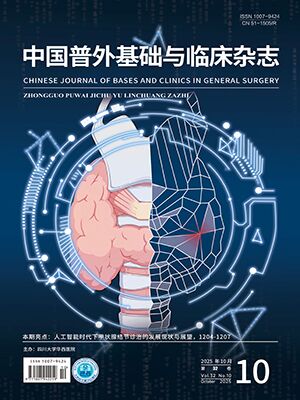| 1. |
Milano AF. 20-year comparative survival and mortality of cancer of the stomach by age, sex, race, stage, grade, cohort entry time-period, disease duration & selected ICD-O-3 oncologic phenotypes: A systematic review of 157 258 cases for diagnosis years 1973–2014: (SEER*Stat 8. 3. 4). J Insur Med, 2019, 48(1): 5-23.
|
| 2. |
Battista S, Ambrosio MR, Limarzi F, et al. Molecular alterations in gastric preneoplastic lesions and early gastric cancer. Int J Mol Sci, 2021, 22(13): 6652. doi: 10.3390/ijms22136652.
|
| 3. |
詹宜, 王炜, 李震寰, 等. 腹腔镜胃癌根治术与传统开腹手术在早期胃癌治疗中的应用效果比较. 癌症进展, 2021, 19(2): 178-182.
|
| 4. |
Ono H, Yao K, Fujishiro M, et al. Guidelines for endoscopic submucosal dissection and endoscopic mucosal resection for early gastric cancer (second edition). Dig Endosc, 2021, 33(1): 4-20.
|
| 5. |
Bourke MJ, Neuhaus H, Bergman JJ. Endoscopic submucosal dissection: Indications and application in Western Endoscopy Practice. Gastroenterology, 2018, 154(7): 1887-1900.
|
| 6. |
刘嵩, 杨林, 郭洁, 等. 两种圈套器改良牵引法辅助内镜黏膜下剥离术治疗上消化道早癌和黏膜下肿瘤的临床对比研究. 中国内镜杂志, 2020, 26(10): 54-61.
|
| 7. |
中华医学会消化内镜学分会, 中国抗癌协会肿瘤内镜专业委员会. 中国早期胃癌筛查及内镜诊治共识意见(2014年, 长沙). 中华消化内镜杂志, 2014, 31(7): 361-377.
|
| 8. |
Dumoulin FL, Hildenbrand R. Endoscopic resection techniques for colorectal neoplasia: Current developments. World J Gastroenterol, 2019, 25(3): 300-307.
|
| 9. |
Barz M, Gerhardt J, Bette S, et al. Prognostic value of tumour volume in patients with a poor Karnofsky performance status scale—A bicentric retrospective study. BMC Neurol, 2021, 21(1): 446. doi: 10.1186/s12883-021-02424-0.
|
| 10. |
Nieuwenhuis EA, Pech O, Bergman JJGHM, et al. Role of endoscopic mucosal resection and endoscopic submucosal dissection in the management of Barrett’s related neoplasia. Gastrointest Endosc Clin N Am, 2021, 31(1): 171-182.
|
| 11. |
Tanaka S, Kashida H, Saito Y, et al. Japan Gastroenterological Endoscopy Society guidelines for colorectal endoscopic submucosal dissection/endoscopic mucosal resection. Dig Endosc, 2020, 32(2): 219-239.
|
| 12. |
邝继孙, 陈文妹, 孔灿灿, 等. 经口牙线牵引辅助内镜下黏膜剥离术治疗早期胃癌的效果及学习曲线分析. 局解手术学杂志, 2020, 29(4): 288-292.
|
| 13. |
Cetinsaya B, Gromski MA, Lee S, et al. A task and performance analysis of endoscopic submucosal dissection (ESD) surgery. Surg Endosc, 2019, 33(2): 592-606.
|
| 14. |
于新颖. 体外与体内辅助牵引技术在内镜黏膜下剥离术中的应用进展. 西南医科大学学报, 2023, 46(2): 175-179.
|
| 15. |
阎冬, 王颜斌, 李文. 经口圈套器牵引辅助下内镜黏膜下剥离术治疗早期胃癌患者的临床疗效及对炎性因子和预后的影响. 癌症进展, 2022, 20(11): 1148-1150, 1154.
|
| 16. |
申志成, 王守立, 赵立志, 等. 改良空肠间置代胃术用于胃癌根治术对患者血常规、营养指数、胃肠激素及CRP水平的影响. 海南医学, 2022, 33(4): 448-451.
|
| 17. |
Arslan B, Dogan G, Orenay-Boyacioglu S, et al. Serotonin, ghrelin, and motilin gene/receptor/transporter polymorphisms in childhood functional constipation. Rev Assoc Med Bras (1992), 2023, 69(2): 279-284.
|
| 18. |
马小红, 赵山虎. 全胸腔镜食管癌手术与传统开胸术对患者炎性应激反应及凝血功能的影响. 血栓与止血学, 2022, 28(1): 92-94.
|
| 19. |
Díaz Del Arco C, Ortega Medina L, Estrada Muñoz L, et al. Is there still a place for conventional histopathology in the age of molecular medicine? Laurén classification, inflammatory infiltration and other current topics in gastric cancer diagnosis and prognosis. Histol Histopathol, 2021, 36(6): 587-613.
|
| 20. |
Liu W, Li Y, Li C. Kirenol exhibits the protective role against N-methyl-N-nitrosourea-induced gastric cancer in rats via modulating the oxidative stress and inflammatory markers. J Environ Pathol Toxicol Oncol, 2020, 39(4): 345-355.
|




